|
|
||||
| home > architetture | ||||
| ROBERTO
PLATANIA. Peter Pan child day-care |
||||
| [in italiano] | Near
the end of the seventies the city of Venice selected a green space in
the Cipressina residential neighbourhood of Mestre (Venice) as the location
for a campus for three school levels, including the Peter Pan child
day-care. Due to the great difference in the students' ages and consequent
needs, separate buildings were constructed on the same property. The
child day-care is a one-storey prefabricated concrete building elevated
above ground that can accommodate up to thirty-five children. |
[03nov2006] | ||
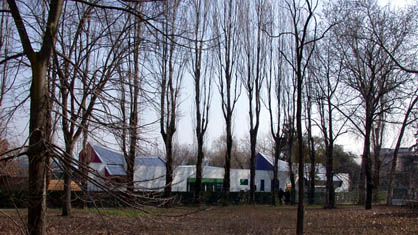 The context in which Peter Pan is inserted is composed of an untidy, poor quality residential area, characteristic of underdeveloped neighbourhood also due to its short distance from the main road. In the early nineties the child day-care was enlarged by an extension to the existing building, an ugly addition in order to create a wing in front of the original school entrance, as a dining- hall. The contracting authority requested additional space to be built next to the dining-hall to create suitable rooms where the children could have naps and rest. |
||||
| Fortunately
schools benefit from the presence of green space, which is rather unfortunately
divided into separate sections with a portion of garden for each school.
This apparent formal contradiction becomes a substantial problem due
to the fact that the maintainability of the project to enlarge the child
day-care has to extend on a long narrow strip of land because the garden
has been divided for no apparent reason. Getting to the point, the open-air
area, which has beautiful tall trees, could be used to co-ordinate functions
and activities for all school levels. |
||||
 The fact that the new Peter Pan, out of the three buildings is the most visible form the street becomes a sign in urban scale and known as a new institution in the educational field. An element of quality within the urban layout enhances the area by establishing a new relationship between existing elements. A contribution to reflect more extensively on the necessity to up-grade the neighbourhood always overcast by the non functionality of the outskirts. The pavilions are a continuation of play areas of the existing structure, thanks to elements of connection in u-glass, although independent from the original structure so as to conserve a clear identity. Therefore, the research to emphasize the "objective" character of new elements using an archetype form, which adapts to the necessity of context of the project area, guaranteeing at the same time a reassuring image for the children. The shapes of the coverings and the different colours of the two buildings are also used to reinforce this theme and distinguish the different ages of the children that use them. |
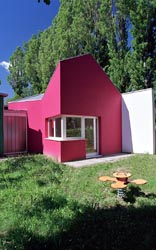 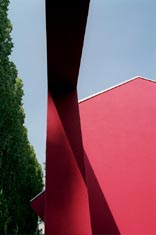  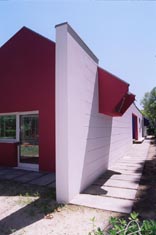 |
|||
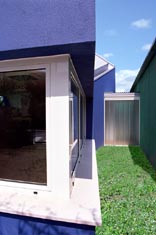  |
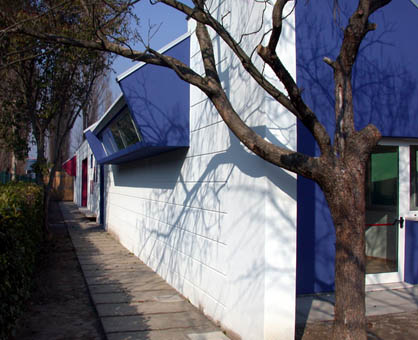 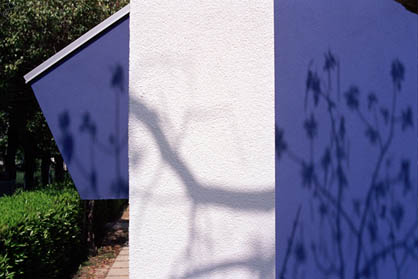 The buildings are linked by a wall about forty-meters long that serves as a sort of regulating element that replaces the unrecognizable façade of the old child day-care. It therefore becomes the true "mainstay" of the project. The wall is also a measuring instrument through which it is possible to perceive the size of the outside play area contrasting with its horizontal position to the vertical position of the natural elements. The wall is an equipped element. The new buildings are connected to it by the bow-windows. The wall is also an instrument of passive architecture that "captures" the refracted rays of the sun during lunch time and redirects them inside the dining-hall. The wall also becomes one of the possible game experiences and discovery opportunities for the small "pupils". The wall is also a reassuring and protective area, it forms a little courtyard where the children can find refreshment in the warmer months. The white wall, ultimately, to frame the colours of the other buildings. STUDIO PLATANIAARCHITETTI | |||
| ROBERTO
PLATANIA. Peter Pan child day-care |
||||
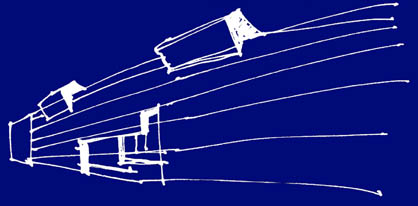 location: Venezia Mestre, Località Cipressina, via Gazzato 2 client: Comune di Venezia Direzione Centrale Progettazione e Esecuzione Lavori Edilizia Scolastica Mestre head director: ing. Salvatore Vento in charge of the proceedure: arch. Michele Lombardi ing. Sandro Colombo project manager: arch. Roberto Platania collaborators: arch. Stefano Seri, arch. Bruno Mongiardo (STUDIO PLATANIAARCHITETTI) landscaper: dott. agr. Marco Tosato structure: ing. Giovanni Cocco geology: dott. Lia Tenderini (Geo Servizi) test builder: ing. arch. Manuel Cattani model: arch. Bruno Mongiardo (STUDIO PLATANIAARCHITETTI) photo: Lisa Ferro video: Marco Donnarumma building constructors: Boato Costruzioni, Marghera VE FBF Impianti Tecnologici, S. Maria di Sala VE technical yard responsible: Mirco Bonaldo, Boato Costruzioni Corrado Secchi, Marco Zeggio - FBF Impianti chronology: October 2002- February 2004 dimensional data: surface: mq 75 volume: mc 370 cost: € 123.000 |
||||
| > STUDIO PLATANIAARCHITETTI | ||||
| Per
candidare progetti laboratorio
|
|||||